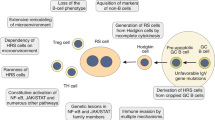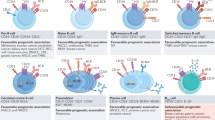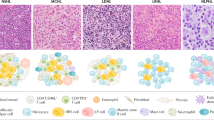Abstract
Clonal interaction between three subpopulations of Ehrlich carcinoma were studied during growth as mixed solid tumours and as ascites tumours in immune-incompetent nude NMRI mice. The tumour cell lines differed in DNA content as determined by DNA flow cytometry (FCM). Tumour growth was evaluated by tumour growth curves including calculation of tumour volume doubling times, tumour weight on day 14, cell cycle times (per cent labelled mitoses) and cell cycle distributions (FCM). Two subpopulations (E1.15 and E1.95) showed nearly identical growth characteristics during both solid and ascites tumour growth. The third subpopulation (E1.80) grew more slowly. FCM on fine-needle tumour aspirates was used to determine the relative proportions of the cell populations in mixed solid tumours in which E1.95 showed a growth-dominating effect on E1.15. No such effect was demonstrated during single-cell tumour growth in ascitic fluid in which the cells had no intimate contact. Ascitic fluid from E1.95-bearing animals or radiation-killed E1.95 cells had no effect on the growth of E1.15, and no remote effect was seen when the two cell lines were growing in opposite flanks. This indicates that only viable E1.95 cells in close in vivo contact were able to induce growth inhibition of the E1.15 subpopulation. Both the E1.95 and the E1.15 cells dominated the E1.80 cells, but in these cases cell kinetic differences may have played a role as the E1.95 and the E1.15 lines grew faster than the E1.80. The E1.80 cell line had no dominating effect on the E1.15 or E1.95. It is concluded that non-immunologically mediated cellular dominance in heterogeneous tumours may contribute to the evolution of these tumours and may be involved in fundamental tumour biological phenomena.
This is a preview of subscription content, access via your institution
Access options
Subscribe to this journal
Receive 24 print issues and online access
$259.00 per year
only $10.79 per issue
Buy this article
- Purchase on Springer Link
- Instant access to full article PDF
Prices may be subject to local taxes which are calculated during checkout
Similar content being viewed by others
Author information
Authors and Affiliations
Rights and permissions
About this article
Cite this article
Aabo, K., Vindeløv, L. & Spang-Thomsen, M. Interaction between three subpopulations of Ehrlich carcinoma in mixed solid tumours in nude mice: evidence of contact domination. Br J Cancer 70, 91–96 (1994). https://doi.org/10.1038/bjc.1994.255
Issue Date:
DOI: https://doi.org/10.1038/bjc.1994.255



